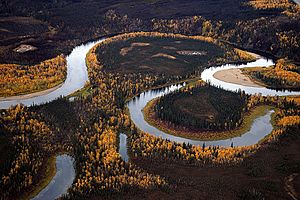Banco Convention of 1905 facts for kids
| Convention Between the United States and Mexico for the Elimination of the Bancos in the Rio Grande from the Effects of Article II of the Treaty of November 12, 1884 | |
|---|---|
| Signed | March 20, 1905 |
| Location | Washington, D.C. |
| Effective | June 5, 1907 |
| Negotiators |
|
| Signatories | |
| Parties |
|
| Languages |
|
The Banco Convention of 1905 was an important agreement between the United States and Mexico. It was signed in 1905 and officially started in 1907. This treaty helped solve problems about land ownership along the Rio Grande and Colorado River. It dealt with "bancos," which are pieces of land that got cut off by changes in the river's path. Between 1910 and 1976, 247 of these land pieces were exchanged between the two countries. Most of these changes happened in the Lower Rio Grande Valley, the Presidio Valley, and the El Paso-Juarez Valley.
Contents
Why the Convention Was Needed
After the Mexican–American War in 1848, the border between the U.S. and Mexico was set along the middle of the Rio Grande and Colorado River. But rivers don't stay still! They often change their paths over time.
River Changes and the Border
In 1884, a treaty tried to make the border rules clearer. It said that if a river changed course slowly, like through soil erosion, the border would move with the river. However, if the river changed course suddenly, like during a flood, the border would stay where it was before.
This sudden change is called "avulsion." When a river makes a sharp bend, it can sometimes cut across the land, leaving a loop of the old riverbed and a piece of land surrounded by water. These isolated pieces of land were called "bancos."
Problems with Bancos
These "bancos" caused a lot of confusion. Imagine a piece of land that used to be in Mexico suddenly becoming surrounded by U.S. territory because the river changed course! This led to questions about who owned the land, which country's laws applied, and how to keep order.
To help with these issues, the International Boundary and Water Commission (IBC) was created in 1889. Its job was to apply the rules from the 1884 treaty. But the problem of "bancos" still wasn't fully solved.
The 1905 Solution
That's where the Banco Convention of 1905 came in. Its main goal was to fix the "banco" problem. It decided that these small pieces of land, or "bancos," would be exchanged between the two countries to keep the border simple and clear. This meant that if a "banco" was created on one side of the river, it would be given to the country on the other side, so the border would always follow the main river channel.
However, not all "bancos" were exchanged. Any "banco" larger than 250 hectares (about 618 acres) or with more than 200 people living on it was not included in this agreement.
What Happened Because of the Convention
The International Boundary and Water Commission was in charge of making sure the convention was followed. Many land exchanges happened, especially in Texas, between 1910 and 1976.
Land Exchanges Over Time
Here's a summary of how many "bancos" were exchanged and how much land was involved:
| Year | No. of bancos | Acres to USA | Acres to Mexico | Year | No. of bancos | Acres to USA | Acres to Mexico | |
|---|---|---|---|---|---|---|---|---|
| 1910 | 57 | 5,357.2 | 3,101.2 | 1942 | 1 | 63.3 | 0 | |
| 1912 | 31 | 1,094.4 | 2,343.0 | 1943 | 4 | 482.9 | 100.5 | |
| 1928 | 42 | 3,089.9 | 1,407.8 | 1944 | 14 | 253.7 | 166.2 | |
| 1930 | 31 | 4,685.6 | 984.3 | 1945 | 16 | 240.9 | 333.5 | |
| 1931 | 4 | 158.4 | 328.7 | 1946 | 1 | 185.8 | 0 | |
| 1932 | 2 | 159.7 | 0 | 1949 | 2 | 190.2 | 281.9 | |
| 1933 | 1 | 0 | 122.1 | 1956 | 1 | 508.3 | 0 | |
| 1934 | 1 | 278.1 | 0 | 1968 | 1 | 0 | 154.6 | |
| 1939 | 1 | 240.2 | 0 | 1970 | 21 | 449.8 | 1,881.8 | |
| 1940 | 2 | 0 | 209.5 | 1976 | 6 | 49.2 | 0 | |
| 1941 | 6 | 224.5 | 246.9 | Total | 245 | 17,712 acres (71.68 km2) | 11,662 acres (47.19 km2) |
Colorado River Bancos
In 1927, this convention was also used for the Colorado River border with Arizona. The U.S. gained two "bancos" from Mexico there: Farmers Banco (about 583 acres) and Fain Banco (about 259 acres).



